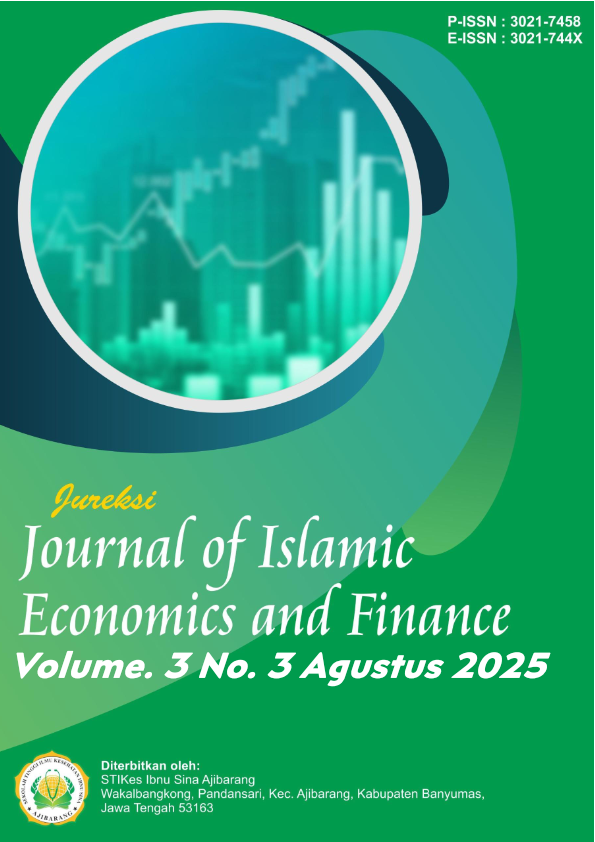Potensi Industri Mebel Berbasis Pemberdayaan Tenaga Kerja Lokal di Kelurahan Bukir, Kota Pasuruan: Analisis Kontribusi Ekonomi dan Penyerapan Tenaga Kerja
DOI:
https://doi.org/10.59841/jureksi.v3i3.2999Keywords:
furniture industry, workforce empowerment, local economy, Bukir Village, PasuruanAbstract
The furniture industry in Bukir Village, Pasuruan City, is one of the leading small and medium-sized industries (SMIs) that contributes significantly to local economic growth and employment. This study aims to analyze the potential of the furniture industry based on the empowerment of local workers, identify its contribution to the regional economy, and evaluate the level of employment in this sector. The research method employs a qualitative approach with data collection techniques through literature review and structured interviews.
The results show that the furniture industry in Bukir Village has grown rapidly since 1980 with the support of the East Java Provincial Technical Implementation Unit (UPT) for Wood. Currently, there are 40 active businesses that can absorb 800-1,200 local workers, equivalent to 85% of the total workforce in the village. This industry uses a made-to-order production system with teak and sonokeling wood as raw materials and has expanded into the export market to Malaysia and other Southeast Asian countries. This study recommends strengthening marketing digitalization, improving human resource skills, and intensifying government support to enhance the competitiveness of the Bukir furniture industry.
References
Acemoglu, D., Autor, D., & Patterson, C. (2024). Bottlenecks: Sectoral imbalances and the US productivity slowdown. NBER Macroeconomics Annual, 38(1), 153–207.
Alaslan, A., Suharti, B., Laxmi, Rustandi, N., Sutrisno, E., & Rahmi, S. (2023). Penelitian metode kualitatif.
Amir, F., Hakim, D. B., & Novianti, T. (2020). Dampak diversifikasi ekspor terhadap pertumbuhan ekonomi negara-negara anggota ASEAN. Jurnal Ekonomi dan Kebijakan Pembangunan, 7(2), 118–139. https://doi.org/10.29244/jekp.7.2.2018.118-139
Annisa Nurrohmi. (2023). Pengaruh keragaman produk mebel dan harga terhadap keputusan pembelian di UD Djati Kusuma Ponorogo. Jurnal Ilmiah, 11(2), 1631–1638.
Bakhri, S. (2020). Membangun ekonomi masyarakat melalui pengembangan (industri kecil menengah). Penerbit K-Media.
Bratu, M. L., & Miricescu, D. (2017). Study on heredity value in communication skills, for improving individual performance in the workplace. MATEC Web of Conferences, 121, 07002.
Capasso, M., & Morrison, A. (2013). Innovation in industrial districts: Evidence from Italy. Management Decision, 51(6), 1225–1249.
El, C., Syafitri, D., Islam, U., Sumatera, N., Nawawi, Z. M., Universitas, D., Negeri, I., & Utara, S. (2025). Peran strategis pengembangan marketing skill UMKM di era persaingan digital yang semakin. Jurnal Ilmu Ekonomi Digital, 2(3), 455–465.
Galib, M. (2024). Transformasi digital UMKM: Analisis pemasaran online dan dampaknya terhadap ekonomi lokal di Indonesia. Journal of Economics and Regional Science, 4(2), 115–128.
Goyal, T. M., & Mukherjee, A. (2017). Trade agreements and services value chain: The case of India and Thailand. Applied Finance and Accounting, 3(1), 11–23.
Hopenhayn, H., Neira, J., & Singhania, R. (2022). From population growth to firm demographics: Implications for concentration, entrepreneurship and the labor share. Econometrica, 90(4), 1879–1914.
Mataram, D. K. (2025). Peran usaha mikro, kecil, dan menengah (UMKM) dalam menurunkan pengangguran dan membuka lapangan kerja. Jurnal Ekonomi dan Ketenagakerjaan, 1(2), 61–67.
Nizaeva, M., & Coşkun, A. (2018). Determinants of the financing obstacles faced by SMEs: An empirical study of emerging economies. Journal of Economic and Social Studies, 7(2), 81.
Pedrazzoli, P., Cavadini, F. A., Corti, D., Barni, A., & Luvini, T. (2014). An innovative production paradigm to offer customized and sustainable wood furniture solutions exploiting the mini-factory concept. In Advances in Production Management Systems (pp. 466–473). IFIP WG 5.7 International Conference, APMS.
Rachmini Saparita, Margono, T., Apriyaldi, E. K., Wijayanti, F., Soesanto, Q. M. B., Carolina, & Savitri Dyah. (2023). Membangun kolaborasi Triple Helix yang ideal (Issue September 2024). https://doi.org/10.55981/brin.740
Rahmat, B., Mulyosari, D., Purwanto, A. A., & Widiyanto, W. (2023). Pengaruh posisi sambungan konstruksi kayu terhadap desain produk mebel berbahan dasar kayu. Jurnal Kreatif: Desain Produk Industri dan Arsitektur, 11(1), 8.
Renie, E. (2020). Partisipasi perempuan dalam ekonomi inklusif. AGENDA: Jurnal Analisis Gender dan Agama, 2(1), 10. https://doi.org/10.31958/agenda.v2i1.1984
Salami, R., Saffari, A., & Khani, M. (2015). Institutional factors in regional innovation systems in industrial clusters using exploratory factor analysis technique: Case study: Tile and ceramic industry. TI Journals. www.tijournals.com
Shaddiq, S. (2025). Resiliensi SDM dalam menghadapi ketidakpastian ekonomi global: Studi kasus sektor industri kreatif. Jurnal Ekonomi Kreatif, 6(1), [Tanpa halaman].
Sigau, A. A., & Shanat, M. (2020). Utilization of semantic values and local community metaphor in creating furniture identity. International Journal of Scientific & Technology Research, 9(1), 1. www.ijstr.org
Utomo, H. J. N., Irwantoro, I., Wasesa, S., Purwati, T., Sembiring, R., & Purwanto, A. (2023). Investigating the role of innovative work behavior, organizational trust, perceived organizational support: An empirical study on SMEs performance. Journal of Law and Sustainable Development, 11(2), 1–19. https://doi.org/10.55908/sdgs.v11i2.417
Downloads
Published
How to Cite
Issue
Section
License
Copyright (c) 2025 Journal of Islamic Economics and Finance

This work is licensed under a Creative Commons Attribution-ShareAlike 4.0 International License.








